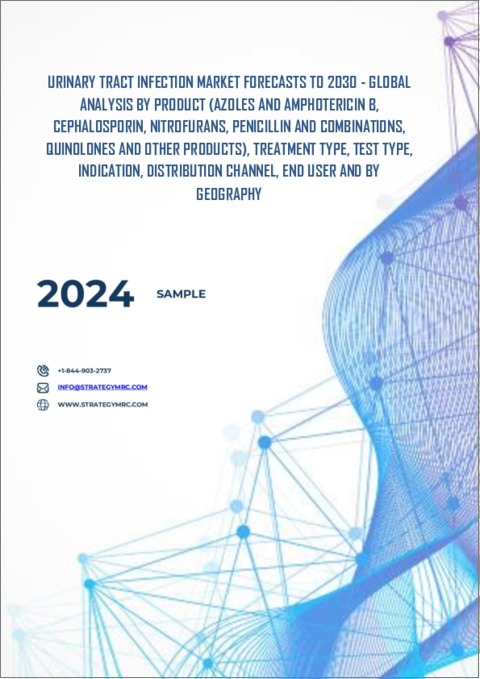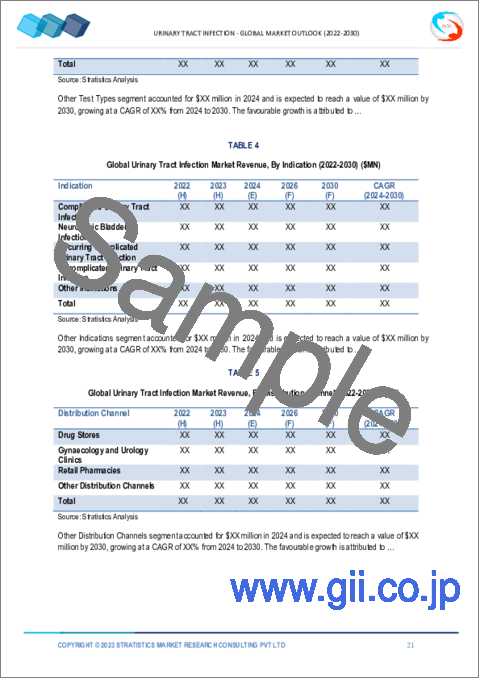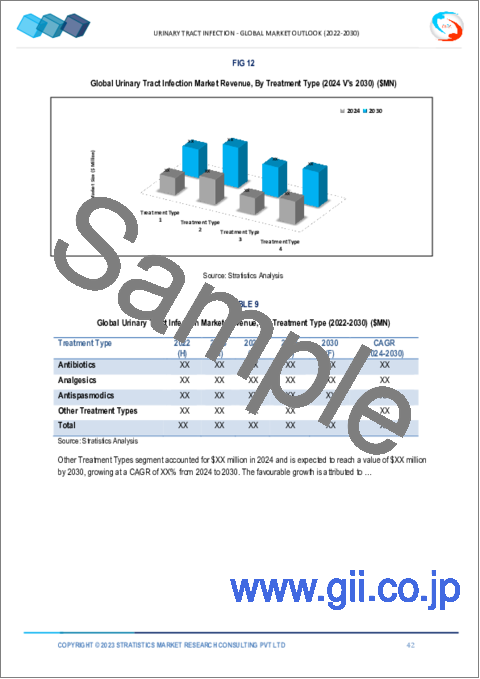|
|
市場調査レポート
商品コード
1403495
尿路感染症市場の2030年までの予測:製品タイプ、治療タイプ、検査タイプ、適応症、流通チャネル、エンドユーザー、地域別の世界分析Urinary Tract Infection Market Forecasts to 2030 - Global Analysis By Product, Treatment Type, Test Type, Indication, Distribution Channel, End User and By Geography |
||||||
カスタマイズ可能
|
|||||||
| 尿路感染症市場の2030年までの予測:製品タイプ、治療タイプ、検査タイプ、適応症、流通チャネル、エンドユーザー、地域別の世界分析 |
|
出版日: 2024年01月01日
発行: Stratistics Market Research Consulting
ページ情報: 英文 200+ Pages
納期: 2~3営業日
|
全表示
- 概要
- 図表
- 目次
Stratistics MRCによると、世界の尿路感染症市場は2023年に66億米ドルを占め、予測期間中にCAGR 7.67%で成長し、2030年には110億7,000万米ドルに達すると予測されています。
尿路感染症は、尿路感染症、腎臓病、糖尿病などの幅広い疾患を検出・管理するための尿検査です。尿路感染症は、主に尿道から侵入した細菌が尿路内で増殖することによって引き起こされ、一般的な病状です。同社は、尿路結石管理に適した診断ツール、抗生物質、治療薬を提供することで、ヘルスケア分野に貢献しています。
米国家庭医学会(AAFP)によると、2020年3月、レオナルド・フェレイラによって、腎臓結石は一般的な病気であり、年間発生率は1,000人当たり8件でした。同出典によれば、男性の約13%、女性の約7%が生涯のうちに腎結石を発症する可能性があり、米国における尿閉の総発生率は男性1,000人当たり年間4.5~6.8人です。
尿路感染症の増加
尿路感染症(UTI)の有病率の増加は、特に女性、高齢者、免疫力の低下した人々において顕著であり、診断および治療の選択肢に対する需要を押し上げています。人口の高齢化、尿路感染症に関する知識の増加、早期発見とタイムリーな治療の重視の高まりは、尿路感染症市場の成長を促進する要因の一部です。さらに、新規の診断薬、抗生物質、予防措置の必要性がこの市場促進要因によって強調されており、尿路結石用の新商品や治療薬の開発への投資や研究が奨励されています。
抗生物質耐性の増加
抗生物質の乱用や誤用による耐性菌の出現により、尿路感染症の効果的な治療が難しくなっています。新しい治療法の必要性は、この耐性菌が現在の抗生物質の有効性を制限し、標準的な治療レジメンを複雑にしているという事実から生じています。尿路結石管理における抗生物質耐性と闘うためには、新たな薬剤や代替治療法を見出すための研究開発に力を注ぐ必要があります。
新しい診断技術の導入
ポイントオブケア診断や迅速分子検査は、尿路結石をより迅速かつ正確に特定するのに役立つ高度な診断ツールの一例です。これにより、抗生物質を効果的に使用することができ、抗生物質耐性の懸念が高まる中、タイムリーな治療が可能となり、患者ケアの向上につながります。最先端の尿路結石診断ソリューションに投資する企業は、正確で効率的な診断技術に対するニーズの高まりから利益を得ることができ、全体的なヘルスケア成果を向上させ、尿路結石治療の経済的負担を軽減することができます。
認識不足
泌尿器系に影響を及ぼす一般的な細菌感染症である尿路結石は、その原因、症状、予防策に関する一般市民の知識が不十分なため、発見されないことが多いです。このような認識不足は、早期診断や適時の医療介入を妨げ、合併症やヘルスケアコストの増加につながります。しかし、衛生習慣に関する誤解や不十分な情報が尿路結石の蔓延を助長しています。認識不足は、個人の健康結果に影響を及ぼすだけでなく、ヘルスケアシステムにも負担をかけています。
COVID-19影響:
ウイルスを管理し封じ込めることに集中するあまり、ヘルスケアの資源、注意、資金が、尿路結石を含む他の病状から遠ざかっています。ロックダウン、医療アクセスの制限、医療機関を訪れることへの患者の不安などが診断や治療の遅れにつながり、尿路結石の重症度を悪化させています。さらに、COVID-19に関連する細菌感染症の治療に抗生物質を使用することが増えたため、抗生物質耐性が生じ、標準的な尿路結石治療の効果が制限される可能性があります。サプライチェーンの混乱も、尿路結石治療薬や診断薬の入手性に影響を与えています。
予測期間中、抗生物質セグメントが最大となる見込み
抗生物質セグメントは予測期間中最大のシェアを占めると予想されます。尿路感染症市場の抗生物質セグメントでは、多種多様な薬剤が尿路細菌感染症の治療に使用されています。アモキシシリンのようなβラクタム系抗生物質やシプロフロキサシンのようなフルオロキノロン系抗生物質は、尿路感染症で頻繁に処方される抗生物質です。さらに、現在進行中の研究開発の目標は、副作用を減らし、耐性を最小限に抑え、これらの抗生物質の有効性を向上させることです。
予測期間中、臨床検査部門が最も高いCAGRが見込まれる
尿路感染症市場における臨床検査部門は、収益性の高い成長が見込まれます。臨床検査室は、尿サンプルの分析を通じて尿路結石を特定・確認する上で極めて重要な役割を担っており、これには細菌の存在の評価や抗生物質の感受性の判定などが含まれます。これらの検査室は、正確でタイムリーな結果を保証し、迅速な医療介入を促進するために、高度な技術と検査方法を利用しています。さらに、自動化や分子診断技術の採用により、尿路結石診断の効率と精度が向上しています。
最もシェアの高い地域
アジア太平洋地域の尿路感染症市場は、医療費の上昇、医療インフラの整備、尿路結石に対する意識の高まりなどを背景に、診断・治療ソリューションの必要性から大きく拡大しています。尿路結石の発生頻度の増加は、ライフスタイルの変化や高齢化にも起因しています。さらに、政府の好意的な取り組みや製薬・ヘルスケア企業の成長が、この地域の成長を後押ししています。
CAGRが最も高い地域:
欧州では、高齢者人口の増加と社会的意識の高まりにより、尿路感染症市場が大幅に拡大しています。糖尿病や尿失禁などの危険因子が一般化していることも欧州の成長を後押ししています。さらに、泌尿器系の健康問題に対する認識を高め、予防対策を奨励する政府のキャンペーンが、欧州連合における市場成長の原動力となっています。
無料のカスタマイズサービス:
本レポートをご購読のお客様には、以下の無料カスタマイズオプションのいずれかをご利用いただけます:
- 企業プロファイル
- 追加市場プレーヤーの包括的プロファイリング(3社まで)
- 主要企業のSWOT分析(3社まで)
- 地域セグメンテーション
- 顧客の関心に応じた主要国の市場推計・予測・CAGR(注:フィージビリティチェックによる)
- 競合ベンチマーキング
- 製品ポートフォリオ、地理的プレゼンス、戦略的提携に基づく主要企業のベンチマーキング
目次
第1章 エグゼクティブサマリー
第2章 序文
- 概要
- ステークホルダー
- 調査範囲
- 調査手法
- データマイニング
- データ分析
- データ検証
- 調査アプローチ
- 調査ソース
- 1次調査ソース
- 2次調査ソース
- 前提条件
第3章 市場動向分析
- 促進要因
- 抑制要因
- 機会
- 脅威
- 製品分析
- エンドユーザー分析
- 新興市場
- 新型コロナウイルス感染症(COVID-19)の影響
第4章 ポーターのファイブフォース分析
- 供給企業の交渉力
- 買い手の交渉力
- 代替品の脅威
- 新規参入業者の脅威
- 競争企業間の敵対関係
第5章 世界の尿路感染症市場:製品別
- アゾールとアムホテリシンB
- セファロスポリン
- ニトロフラン
- ペニシリンとその組み合わせ
- キノロン類
- その他の製品
第6章 世界の尿路感染症市場:治療タイプ別
- 抗生物質
- 鎮痛剤
- 鎮痙薬
- その他の治療タイプ
第7章 世界の尿路感染症市場:検査タイプ別
- 顕微鏡的尿路感染症
- 生化学的尿路感染症
- フローサイトメトリーによる尿路感染症
- その他の検査タイプ
第8章 世界の尿路感染症市場:適応症別
- 複雑性尿路感染症
- 神経因性膀胱感染症
- 再発複雑性尿路感染症
- 単純性尿路感染症
- その他の適応症
第9章 世界の尿路感染症市場:流通チャネル別
- ドラッグストア
- 婦人科および泌尿器科クリニック
- 小売薬局
- その他の流通チャネル
第10章 世界の尿路感染症市場:エンドユーザー別
- 病院
- 臨床検査室
- 在宅ヘルスケア
- その他のエンドユーザー
第11章 世界の尿路感染症市場:地域別
- 北米
- 米国
- カナダ
- メキシコ
- 欧州
- ドイツ
- 英国
- イタリア
- フランス
- スペイン
- その他欧州
- アジア太平洋地域
- 日本
- 中国
- インド
- オーストラリア
- ニュージーランド
- 韓国
- その他アジア太平洋地域
- 南米
- アルゼンチン
- ブラジル
- チリ
- その他南米
- 中東とアフリカ
- サウジアラビア
- アラブ首長国連邦
- カタール
- 南アフリカ
- その他中東とアフリカ
第12章 主な発展
- 契約、パートナーシップ、コラボレーション、合弁事業
- 買収と合併
- 新製品の発売
- 事業拡大
- その他の主要戦略
第13章 企業プロファイル
- Abbott Laboratories
- Acon Laboratories, Inc.
- Allergan Plc
- Arkray, Inc.
- Astrazeneca Plc
- Bayer Ag
- Beckman Coulter, Inc.
- Bio-Rad Laboratories, Inc.
- Elektronika Kft.
- F. Hoffmann-La Roche Ltd
- Glaxosmithkline Plc
- Johnson & Johnson
- Merck & Co. Inc
- Mindray Medical International Limited
- Novartis Ag
- Pfizer Inc
- Roche Diagnostics
- Sanofi S.A.
- Siemens Healthcare
- Sysmex Corporation
- Urit Medical Electronic Group Co., Ltd.
List of Tables
- Table 1 Global Urinary Tract Infection Market Outlook, By Region (2021-2030) ($MN)
- Table 2 Global Urinary Tract Infection Market Outlook, By Product (2021-2030) ($MN)
- Table 3 Global Urinary Tract Infection Market Outlook, By Azoles and Amphotericin B (2021-2030) ($MN)
- Table 4 Global Urinary Tract Infection Market Outlook, By Cephalosporin (2021-2030) ($MN)
- Table 5 Global Urinary Tract Infection Market Outlook, By Nitrofurans (2021-2030) ($MN)
- Table 6 Global Urinary Tract Infection Market Outlook, By Penicillin and Combinations (2021-2030) ($MN)
- Table 7 Global Urinary Tract Infection Market Outlook, By Quinolones (2021-2030) ($MN)
- Table 8 Global Urinary Tract Infection Market Outlook, By Other Products (2021-2030) ($MN)
- Table 9 Global Urinary Tract Infection Market Outlook, By Treatment Type (2021-2030) ($MN)
- Table 10 Global Urinary Tract Infection Market Outlook, By Antibiotics (2021-2030) ($MN)
- Table 11 Global Urinary Tract Infection Market Outlook, By Analgesics (2021-2030) ($MN)
- Table 12 Global Urinary Tract Infection Market Outlook, By Antispasmodics (2021-2030) ($MN)
- Table 13 Global Urinary Tract Infection Market Outlook, By Other Treatment Types (2021-2030) ($MN)
- Table 14 Global Urinary Tract Infection Market Outlook, By Test Type (2021-2030) ($MN)
- Table 15 Global Urinary Tract Infection Market Outlook, By Microscopic Urinary Tract Infections (2021-2030) ($MN)
- Table 16 Global Urinary Tract Infection Market Outlook, By Biochemical Urinary Tract Infections (2021-2030) ($MN)
- Table 17 Global Urinary Tract Infection Market Outlook, By Flow Cytometric Urinary Tract Infections (2021-2030) ($MN)
- Table 18 Global Urinary Tract Infection Market Outlook, By Other Test Types (2021-2030) ($MN)
- Table 19 Global Urinary Tract Infection Market Outlook, By Indication (2021-2030) ($MN)
- Table 20 Global Urinary Tract Infection Market Outlook, By Complicated Urinary Tract Infection (2021-2030) ($MN)
- Table 21 Global Urinary Tract Infection Market Outlook, By Neurogenic Bladder Infections (2021-2030) ($MN)
- Table 22 Global Urinary Tract Infection Market Outlook, By Recurring Complicated Urinary Tract Infection (2021-2030) ($MN)
- Table 23 Global Urinary Tract Infection Market Outlook, By Uncomplicated Urinary Tract Infection (2021-2030) ($MN)
- Table 24 Global Urinary Tract Infection Market Outlook, By Other Indications (2021-2030) ($MN)
- Table 25 Global Urinary Tract Infection Market Outlook, By Distribution Channel (2021-2030) ($MN)
- Table 26 Global Urinary Tract Infection Market Outlook, By Drug Stores (2021-2030) ($MN)
- Table 27 Global Urinary Tract Infection Market Outlook, By Gynaecology and Urology Clinics (2021-2030) ($MN)
- Table 28 Global Urinary Tract Infection Market Outlook, By Retail Pharmacies (2021-2030) ($MN)
- Table 29 Global Urinary Tract Infection Market Outlook, By Other Distribution Channels (2021-2030) ($MN)
- Table 30 Global Urinary Tract Infection Market Outlook, By End User (2021-2030) ($MN)
- Table 31 Global Urinary Tract Infection Market Outlook, By Hospitals (2021-2030) ($MN)
- Table 32 Global Urinary Tract Infection Market Outlook, By Clinical Laboratories (2021-2030) ($MN)
- Table 33 Global Urinary Tract Infection Market Outlook, By Home Healthcare (2021-2030) ($MN)
- Table 34 Global Urinary Tract Infection Market Outlook, By Other End Users (2021-2030) ($MN)
Note: Tables for North America, Europe, APAC, South America, and Middle East & Africa Regions are also represented in the same manner as above.
According to Stratistics MRC, the Global Urinary Tract Infection Market is accounted for $6.60 billion in 2023 and is expected to reach $11.07 billion by 2030 growing at a CAGR of 7.67% during the forecast period. Urinary Tract Infections is a test of urine to detect and manage a wide range of disorders, such as urinary tract infections, kidney disease and diabetes. UTIs, caused primarily by bacteria entering the urethra and multiplying in the urinary tract, are common medical conditions. It serves the healthcare sector by providing diagnostic tools, antibiotics, and therapeutics tailored for UTI management.
According to the American Academy of Family Physicians (AAFP), in March 2020, by Leonardo Ferreira, kidney stones were a common ailment, with an annual incidence of eight instances per 1,000 persons. As per the same source, around 13% of men and 7% of women may develop a kidney stone during their lifetime, and the total incidence of urinary retention in the US is 4.5 to 6.8 per 1,000 men per year.
Market Dynamics:
Driver:
Increasing prevalence of urinary tract infections
The increasing prevalence of urinary tract infections (UTIs), especially in women, the elderly, and people with weakened immune systems, is driving up demand for diagnostic and treatment options. The aging population, increased knowledge of UTIs, and a growing emphasis on early detection and timely treatment are some of the factors driving the UTI market's growth. Furthermore, the need for novel diagnostics, antibiotics, and preventive measures is highlighted by this market driver, which encourages investment and research in the creation of fresh goods and remedies for UTIs.
Restraint:
Rising instances of antibiotic resistance
Effective treatment of urinary tract infections is becoming more difficult due to the emergence of resistant bacterial strains caused by the overuse and misuse of antibiotics. The need for new therapeutic solutions arises from the fact that this resistance limits the effectiveness of current antibiotics and complicates standard treatment regimens. In order to combat antibiotic resistance in UTI management, research and development efforts must be concentrated in order to find new medications and alternative treatment modalities.
Opportunity:
Adoption of novel diagnostic technologies
Point-of-care diagnostics and rapid molecular testing are instances of advanced diagnostic tools that can help identify UTIs more quickly and accurately. This helps to effectively use antibiotics, addressing the growing concern of antibiotic resistance, and improves patient care by enabling timely treatment. Businesses that invest in cutting-edge UTI diagnostic solutions will profit from the growing need for accurate and efficient diagnostic techniques, which will enhance overall healthcare outcomes and lessen the financial burden of UTI treatment.
Threat:
Lack of awareness
UTIs, common bacterial infections affecting the urinary system, often go undetected due to insufficient public knowledge about their causes, symptoms, and preventive measures. This dearth of awareness hampers early diagnosis and timely medical intervention, leading to complications and increased healthcare costs. However, misconceptions and inadequate information about hygiene practices contribute to the prevalence of UTIs. The lack of awareness not only affects individual health outcomes but also burdens healthcare systems.
COVID-19 Impact:
The overwhelming focus on managing and containing the virus has diverted healthcare resources, attention, and funding away from other medical conditions, including UTIs. Lockdowns, restricted healthcare access, and patient concerns about visiting medical facilities have led to delayed diagnoses and treatments, exacerbating the severity of UTIs. Moreover, the increased use of antibiotics to treat COVID-19-related bacterial infections has contributed to antibiotic resistance, potentially limiting the effectiveness of standard UTI treatments. Supply chain disruptions have also affected the availability of UTI medications and diagnostics.
The antibiotics segment is expected to be the largest during the forecast period
The antibiotics segment expected to have largest share over the anticipated period. A wide variety of medications are used to treat bacterial infections of the urinary tract in the Urinary Tract Infection market's antibiotics segment. Beta-lactam antibiotics, like amoxicillin, and fluoroquinolones, like ciprofloxacin, are frequently prescribed antibiotics for urinary tract infections. Additionally, the goals of ongoing research and development are to reduce side effects, minimize resistance, and improve the effectiveness of these antibiotics.
The clinical laboratories segment is expected to have the highest CAGR during the forecast period
Clinical laboratories segment in the urinary tract infection market is expected to have profitable growth. Clinical laboratories are pivotal in the identification and confirmation of UTIs through the analysis of urine samples, which includes assessing bacterial presence and determining antibiotic susceptibility. These laboratories utilize advanced technologies and testing methods to ensure accurate and timely results, facilitating prompt medical intervention. Moreover, the adoption of automation and molecular diagnostic techniques within these laboratories enhances the efficiency and precision of UTI diagnostics.
Region with largest share:
The Asia-Pacific Urinary Tract Infection market is expanding substantially due to the need for diagnostic and treatment solutions is being driven by rising healthcare costs, better healthcare infrastructure, and increased awareness of UTIs. The increased frequency of UTIs is also attributed to a changing lifestyle and an aging population. Additionally, favourable government initiatives and the growth of pharmaceutical and healthcare companies are driving the regional growth.
Region with highest CAGR:
The market for urinary tract infections is expanding substantially in Europe due to a growing geriatric population and rising public awareness. The market is growing due to risk factors like diabetes and urine incontinence are becoming more common, which is also driving growth in Europe. Additionally, government campaigns to raise awareness of urinary health issues and encourage preventative measures have been crucial in driving market growth in the European Union.
Key players in the market:
Some of the key players in Urinary Tract Infection market include Abbott Laboratories , Acon Laboratories, Inc., Allergan Plc, Arkray, Inc., Astrazeneca Plc, Bayer Ag , Beckman Coulter, Inc., Bio-Rad Laboratories, Inc., Elektronika Kft., F. Hoffmann-La Roche Ltd, Glaxosmithkline Plc, Johnson & Johnson, Merck & Co. Inc, Mindray Medical International Limited, Novartis Ag, Pfizer Inc, Roche Diagnostics, Sanofi S.A., Siemens Healthcare, Sysmex Corporation and Urit Medical Electronic Group Co., Ltd.
Key Developments:
In December 2023, Fujirebio Holdings, Inc. and Sysmex Corporation announced that they have signed an agreement for the mutual supply of reagent raw materials owned by both companies. The Agreement is based on a basic agreement on business collaboration in the field of immunoassay. Under the terms of the Agreement, Fujirebio and Sysmex will mutually supply a wide range of reagent materials owned by each company, mainly antigens and antibodies, which are the main raw materials of immunoassay reagents.
In December 2023, AstraZeneca Pharma India has entered into a Memorandum of Understanding (MoU) with Roche Diagnostics India to enhance diagnostics for breast cancer patients, particularly focusing on refining HER2 diagnostics with the latest advancements. This strategic alliance aligns with AstraZeneca's commitment to advancing patient-centric healthcare solutions and Roche Diagnostics' dedication to pioneering diagnostic innovation.
Products Covered:
- Azoles and Amphotericin B
- Cephalosporin
- Nitrofurans
- Penicillin and Combinations
- Quinolones
- Other Products
Treatment Types Covered:
- Antibiotics
- Analgesics
- Antispasmodics
- Other Treatment Types
Test Types Covered:
- Microscopic Urinary Tract Infections
- Biochemical Urinary Tract Infections
- Flow Cytometric Urinary Tract Infections
- Other Test Types
Indications Covered:
- Complicated Urinary Tract Infection
- Neurogenic Bladder Infections
- Recurring Complicated Urinary Tract Infection
- Uncomplicated Urinary Tract Infection
- Other Indications
Distribution Channels Covered:
- Drug Stores
- Gynaecology and Urology Clinics
- Retail Pharmacies
- Other Distribution Channels
End Users Covered:
- Hospitals
- Clinical Laboratories
- Home Healthcare
- Other End Users
Regions Covered:
- North America
- US
- Canada
- Mexico
- Europe
- Germany
- UK
- Italy
- France
- Spain
- Rest of Europe
- Asia Pacific
- Japan
- China
- India
- Australia
- New Zealand
- South Korea
- Rest of Asia Pacific
- South America
- Argentina
- Brazil
- Chile
- Rest of South America
- Middle East & Africa
- Saudi Arabia
- UAE
- Qatar
- South Africa
- Rest of Middle East & Africa
What our report offers:
- Market share assessments for the regional and country-level segments
- Strategic recommendations for the new entrants
- Covers Market data for the years 2021, 2022, 2023, 2026, and 2030
- Market Trends (Drivers, Constraints, Opportunities, Threats, Challenges, Investment Opportunities, and recommendations)
- Strategic recommendations in key business segments based on the market estimations
- Competitive landscaping mapping the key common trends
- Company profiling with detailed strategies, financials, and recent developments
- Supply chain trends mapping the latest technological advancements
Free Customization Offerings:
All the customers of this report will be entitled to receive one of the following free customization options:
- Company Profiling
- Comprehensive profiling of additional market players (up to 3)
- SWOT Analysis of key players (up to 3)
- Regional Segmentation
- Market estimations, Forecasts and CAGR of any prominent country as per the client's interest (Note: Depends on feasibility check)
- Competitive Benchmarking
- Benchmarking of key players based on product portfolio, geographical presence, and strategic alliances
Table of Contents
1 Executive Summary
2 Preface
- 2.1 Abstract
- 2.2 Stake Holders
- 2.3 Research Scope
- 2.4 Research Methodology
- 2.4.1 Data Mining
- 2.4.2 Data Analysis
- 2.4.3 Data Validation
- 2.4.4 Research Approach
- 2.5 Research Sources
- 2.5.1 Primary Research Sources
- 2.5.2 Secondary Research Sources
- 2.5.3 Assumptions
3 Market Trend Analysis
- 3.1 Introduction
- 3.2 Drivers
- 3.3 Restraints
- 3.4 Opportunities
- 3.5 Threats
- 3.6 Product Analysis
- 3.7 End User Analysis
- 3.8 Emerging Markets
- 3.9 Impact of Covid-19
4 Porters Five Force Analysis
- 4.1 Bargaining power of suppliers
- 4.2 Bargaining power of buyers
- 4.3 Threat of substitutes
- 4.4 Threat of new entrants
- 4.5 Competitive rivalry
5 Global Urinary Tract Infection Market, By Product
- 5.1 Introduction
- 5.2 Azoles and Amphotericin B
- 5.3 Cephalosporin
- 5.4 Nitrofurans
- 5.5 Penicillin and Combinations
- 5.6 Quinolones
- 5.7 Other Products
6 Global Urinary Tract Infection Market, By Treatment Type
- 6.1 Introduction
- 6.2 Antibiotics
- 6.3 Analgesics
- 6.4 Antispasmodics
- 6.5 Other Treatment Types
7 Global Urinary Tract Infection Market, By Test Type
- 7.1 Introduction
- 7.2 Microscopic Urinary Tract Infections
- 7.3 Biochemical Urinary Tract Infections
- 7.4 Flow Cytometric Urinary Tract Infections
- 7.5 Other Test Types
8 Global Urinary Tract Infection Market, By Indication
- 8.1 Introduction
- 8.2 Complicated Urinary Tract Infection
- 8.3 Neurogenic Bladder Infections
- 8.4 Recurring Complicated Urinary Tract Infection
- 8.5 Uncomplicated Urinary Tract Infection
- 8.6 Other Indications
9 Global Urinary Tract Infection Market, By Distribution Channel
- 9.1 Introduction
- 9.2 Drug Stores
- 9.3 Gynaecology and Urology Clinics
- 9.4 Retail Pharmacies
- 9.5 Other Distribution Channels
10 Global Urinary Tract Infection Market, By End User
- 10.1 Introduction
- 10.2 Hospitals
- 10.3 Clinical Laboratories
- 10.4 Home Healthcare
- 10.5 Other End Users
11 Global Urinary Tract Infection Market, By Geography
- 11.1 Introduction
- 11.2 North America
- 11.2.1 US
- 11.2.2 Canada
- 11.2.3 Mexico
- 11.3 Europe
- 11.3.1 Germany
- 11.3.2 UK
- 11.3.3 Italy
- 11.3.4 France
- 11.3.5 Spain
- 11.3.6 Rest of Europe
- 11.4 Asia Pacific
- 11.4.1 Japan
- 11.4.2 China
- 11.4.3 India
- 11.4.4 Australia
- 11.4.5 New Zealand
- 11.4.6 South Korea
- 11.4.7 Rest of Asia Pacific
- 11.5 South America
- 11.5.1 Argentina
- 11.5.2 Brazil
- 11.5.3 Chile
- 11.5.4 Rest of South America
- 11.6 Middle East & Africa
- 11.6.1 Saudi Arabia
- 11.6.2 UAE
- 11.6.3 Qatar
- 11.6.4 South Africa
- 11.6.5 Rest of Middle East & Africa
12 Key Developments
- 12.1 Agreements, Partnerships, Collaborations and Joint Ventures
- 12.2 Acquisitions & Mergers
- 12.3 New Product Launch
- 12.4 Expansions
- 12.5 Other Key Strategies
13 Company Profiling
- 13.1 Abbott Laboratories
- 13.2 Acon Laboratories, Inc.
- 13.3 Allergan Plc
- 13.4 Arkray, Inc.
- 13.5 Astrazeneca Plc
- 13.6 Bayer Ag
- 13.7 Beckman Coulter, Inc.
- 13.8 Bio-Rad Laboratories, Inc.
- 13.9 Elektronika Kft.
- 13.10 F. Hoffmann-La Roche Ltd
- 13.11 Glaxosmithkline Plc
- 13.12 Johnson & Johnson
- 13.13 Merck & Co. Inc
- 13.14 Mindray Medical International Limited
- 13.15 Novartis Ag
- 13.16 Pfizer Inc
- 13.17 Roche Diagnostics
- 13.18 Sanofi S.A.
- 13.19 Siemens Healthcare
- 13.20 Sysmex Corporation
- 13.21 Urit Medical Electronic Group Co., Ltd.






